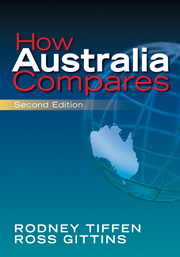Book contents
- Frontmatter
- Contents
- List of tables and figures
- Preface to the second edition
- Acknowledgements
- Reading the tables
- Abbreviations
- Introduction
- 1 People
- 2 Government and politics
- 3 Economics
- 4 Work and labour
- 5 Government taxes and spending
- 6 Health
- 7 Education
- 8 Inequality and social welfare
- 9 International relations
- 10 Environment
- 11 Science and technology
- 12 Telecommunications and computing
- 13 Media
- 14 Family
- 15 Lifestyles and consumption
- 16 Crime and social problems
- 17 The search for scoreboards
- 18 The Howard impact
- Sources and references
2 - Government and politics
Published online by Cambridge University Press: 05 June 2012
- Frontmatter
- Contents
- List of tables and figures
- Preface to the second edition
- Acknowledgements
- Reading the tables
- Abbreviations
- Introduction
- 1 People
- 2 Government and politics
- 3 Economics
- 4 Work and labour
- 5 Government taxes and spending
- 6 Health
- 7 Education
- 8 Inequality and social welfare
- 9 International relations
- 10 Environment
- 11 Science and technology
- 12 Telecommunications and computing
- 13 Media
- 14 Family
- 15 Lifestyles and consumption
- 16 Crime and social problems
- 17 The search for scoreboards
- 18 The Howard impact
- Sources and references
Summary
Constitutional history
These 18 countries were chosen because for more than the last half century they have continuously fulfilled minimal requirements for liberal democracies. This emphatically does not mean that they are ideal democracies, or that there is not scope for further improvement towards democratic ideals. It means that for this period their governments have always changed according to constitutional processes, and that they have had to face regularly scheduled, fairly conducted, competitive elections in which (close to) all the adult population could vote. They have thus met the criteria of inclusiveness, competitiveness and constitutionality.
Australia is one of about half a dozen countries which had continuous elections throughout the 20th century. Another half dozen or so West European countries were always democratic except for periods of foreign occupation in wartime. Finally a third group achieved varying degrees of representative democracy but later relapsed into authoritarian rule, before again becoming liberal democracies after the end of World War II. This group includes the vanquished Axis powers, but also France (which had the most constitutionally problematic change during the contemporary period, namely the 1958 accession of de Gaulle to the presidency, and subsequent change from the Fourth to the Fifth Republic).
The tables reveal that democracy rarely emerged fully blown, and did not come all at once to these countries. Rather there was often a series of struggles. In particular, many countries manifested degrees of competitiveness and pluralism before they became fully inclusive.
- Type
- Chapter
- Information
- How Australia Compares , pp. 24 - 45Publisher: Cambridge University PressPrint publication year: 2009

